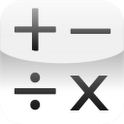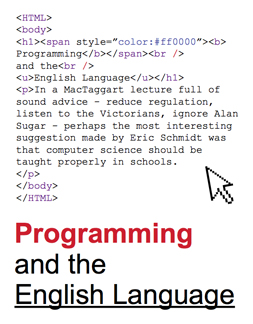
Tim is the Editor of the Innovate My School Magazine. Before joining Innovate, he worked for five years in the software industry, occupying every role from tea-making technical support specialist to programmer and project director. He writes about a range of subjects, including education, technology, history and religion.

Sample questions from the Government's new “back to basics” grammar, spelling and punctuation test for 11-year-olds were released this week.
Here are three superb literacy-related resources for all teachers - whether they're looking for a way to improve pupils' punctuation, a refresher course on comma conventions, or some intriguing information about where grammar came from and why it matters.
Mignon Forgarty, otherwise known as Grammar Girl, maintains and writes for this site, which contains tips and guidance about writing. She and other contributors frequently (though, as literacy buffs will note, not always regularly) post articles about common grammatical errors, usage, style, idiom, word choice, etc. Though most posts are written by Americans, the website generally mentions British English alternatives when necessary. The site's archive is particularly useful for those who are uncertain about a convention, and for anyone with a general enthusiasm for writing accurately and effectively.

The Christmas holidays should be a time for mulling wine and pulling crackers. But many teachers will spend at least some of the festive period wondering - and worrying about - how well their pupils are preparing for January exams.
To assuage the anxiety, here are six YouTube videos that should help your pupils maximise their memories.
In this video, Andi Bell demonstrates a simple technique for easily memorising and recalling information. His example involves memorising a sequence of random words, but the approach should work equally well for learning mathematical formulae, abstract facts, or a sequences of dates and events.
The Government has said that calculators will be banned in maths tests for 11-year-olds from 2014. Here are five cool apps for Android and IOS that should help pupils to sharpen their mental arithmetic and learn how to do more maths in their minds.

A no-nonsense app with a plain but clean interface, Math Workout helps pupils practice addition, subtraction, multiplication, division, indices, decimals and more. Its “Brain Cruncher” mode is good for training the mind to hold numbers in memory, and the “Times Table Master” should be particularly useful to primary pupils who are laerning their tables. Players must complete quite a few rounds on the easier levels to unlock the harder ones: this should ensure that pupils master the basics before moving on to harder questions, though it may irritate more accomplished mental mathematicians.
Links to app: Android, Android (Free version)

In a MacTaggart lecture full of sound advice - reduce regulation, listen to the Victorians, ignore Alan Sugar - perhaps the most important suggestion made by Eric Schmidt was that computer science be taught properly in schools.
This means, as the Google Chairman pointed out, teaching children how to make computer programs rather than merely how to use them.
But in an era when GCSE marks are awarded for linking a picture of a football to the word “le football”, can pupils really cope with the protean rigours of computer programming?
Of course they can. Today’s children grow up surrounded by software. They enjoy using it so much that they are largely self-taught. They eagerly upgrade to the latest mobile phone, even if this means learning to use an entirely new operation system. Such enthusiasm and confidence are the perfect foundations on which to learn to program.

Politicians often remind us that we live in a modern world. A modern world, they say, requires a modern approach.
The first statement - that we live in a modern world - is so obvious that one is tempted to accept the second as equally self-evident, when in fact it is not.
The fact that a thing or idea is new or recent (which is all "modern" means) does not necessarily make it better than something older.
Of course, those in power want us to think that it does, because they want to bring in their own new ideas, or have recently done so. For them, admitting the superiority of an older way of doing things would mean conceding that there is no need for their new ideas (and no need for us to pay for them) or that the ideas they recently introduced have failed.
So they don't admit it. Instead they try to trick us into thinking that newer is always better: they use words such as modern and progressive as if they were synonymous with good; they scorn opponents for wanting to "turn back the clock", as if doing so would be unquestionably bad.
The content of the first email may have been forgettable, but when Ray Tomlinson first fizzed that message over the ARPANET between two side-by-side computers in a Cambridge laboratory, communication changed forever. That was in 1971. Since then email has remained, despite decades of technological innovations, the staple tool for communication between computers.
By rights it should be a redundant relic, rusting beneath the surging tides of technological evolution. Instead, email is more integral to our lives than ever. It is hard to imagine the most consummate maestro of instant messaging, inveterate IRC idler or turgid Twitterer considering, even for a moment, that anything short of the grim reaper himself could render his trusty email account unnecessary.
Admittedly the currents of change have shined its surface somewhat, but at its core, modern email is still the snail mail imitating, “to me, to you” messaging system that was invented almost forty years ago, before even the internet itself was established (and long before the Chuckle brothers first uttered their timeless mantra).
It is a living fossil that we could not live without. Whatever the reasons for its longevity, it can be said with confidence that if email did not exist, it would be necessary to invent it.
But what would email be like if it were invented today?
Wave is Google’s answer. Announced in May 09 and currently in an extended preview release, it is a real-time communications and collaboration tool that aims, through a fusion of the internet-based communications technologies of the last decade, to be the reinvention of email.
When you send an email, each recipient gets a copy of the message and can reply to it by sending another email. A wave, in contrast, is a “hosted conversation”: a single, living document which can be updated, edited and viewed by everyone who has been invited to participate in it.
But to compare a wave to an email is only to glimpse its glinting crest. A brief plunge into the fathoms of potential beneath (school goggles firmly attached) reveals several tantalising prospects for Wave’s application in education.
• Real-time Collaboration
Everything within a wave occurs in real time. Participants can see changes made to a wave by other participants as they happen, character by character, with each participant’s contributions distinguished by colour. Students could work together on a wave without the need to crowd around a single computer, and could participate in collaborative assignments from their separate homes. Without leaving their desks, teachers could view students’ waves as they develop and add comments or corrections at relevant points. The promised availability of rich-text formats, including graphs, graphics and pictures, should make wave documents suitable for a variety of different subjects.
• Playback
Perhaps Wave’s biggest draw as a collaborative editing tool is the ability to "play back" - again, character by character - a wave’s history. This eliminates the potential for version errors (which can occur when two people try to edit the same part of a document at the same time). It could also enable teachers to see exactly what each student has contributed to a collaborative wave.
• Bots
The pace of progress in computing is both augmented and exemplified by the recent emergence of a horde of independent developers, armed to the teeth with the tools and creativity to take communication to new levels. Google hope these developers will really push their bid to make Wave the world’s preferred communications tool.
Google want independent developers to add functionality to Wave by creating “bots”. A bot is a piece of code that can be added to any wave, and that allows the wave’s participants some additional functionality. For example, if one were to add the “Rosy” bot to a wave, it would automatically translate (in real-time) everything a participant typed in English into French, and vice versa. Another bot, “Bloggy”, enables the automatic conversion of a wave into a blog post.
By providing full, open-source access to their API, Google hope to encourage huge numbers of developers to contribute bots that will make Wave the richest and most fully engaged communications tool available. With the right bots, integration with Virtual Learning Environments and the ability to export a wave to any document format could be achieved with just a few clicks.
The preview version of Wave has received its share of criticism, and it’s true that the interface is quite cramped and feels unnatural - shortcuts are confusing, and when more than two or three people reply and re-reply to different segments of a wave, it can become very complex, very quickly.
For this latter reason in particular (and, obviously, because of decades of habit), it’s likely that we’ll see waves used in exactly the same way as emails – new waves created as replies to existing ones - for some time yet, and so long as this is true, Wave cannot convincingly claim to be the reinvention of email.
But if Google address the feedback of their users and developers before the product's full release, Wave could certainly become a new stage in email's evolution – and a powerful tool for collaborative work.

A community-driven platform for showcasing the latest innovations and voices in schools
Pioneer House
North Road
Ellesmere Port
CH65 1AD
United Kingdom